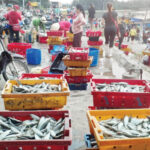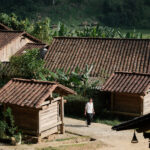The construction of the Damnoen Saduak Canal was a visionary move by King Rama IV to facilitate transportation from the capital city of Bangkok to the western coastal regions. The 35-kilometer canal, connecting the Tha Chin and Mae Klong rivers, provided a straight and convenient water route for commerce, overcoming the challenges posed by the previously difficult terrain and complex network of rivers.
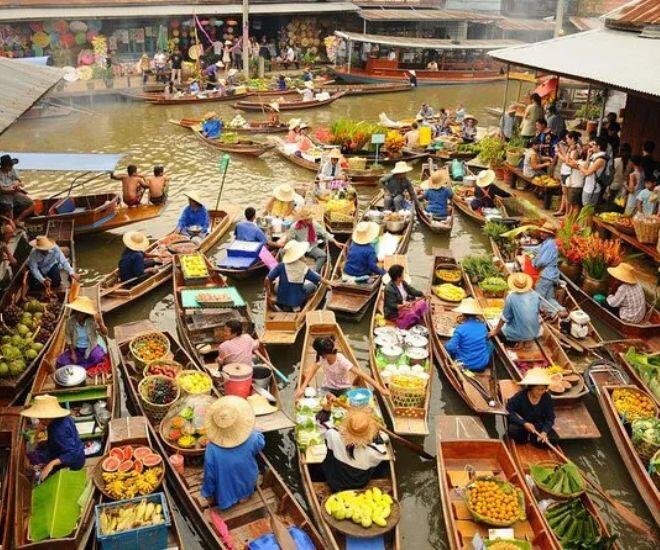
This engineering marvel not only improved transportation but also opened up economic opportunities for the entire region. The completion of the canal triggered a wave of migration, with people from neighboring provinces and Chinese immigrants from southern China settling in the area, transforming what was once a desolate land into a thriving agricultural hub.
The Organic Evolution of a Floating Market
In the late 19th century, as the orchards and vegetable gardens along the canal started yielding harvests, boats carrying produce naturally congregated along the waterway. What began as small-scale exchanges between farmers and traders gradually evolved into a regular floating market.
The unique geography of the area facilitated this development. Located at coordinates 13°31′3″N 99°57′17″E, Damnoen Saduak sits at the intersection of three provinces: Ratchaburi, Samut Sakhon, and Samut Songkhram. This strategic position made it a crucial transportation hub, easily accessible to trading boats from across the Chao Phraya River plain.
A Bounty of Tropical Produce
Today, visitors to the Damnoen Saduak Floating Market are treated to a living museum of tropical produce. The region of Ratchaburi, with its mild climate and fertile alluvial soil, produces high-quality agricultural goods that are highly regarded by domestic and international consumers.
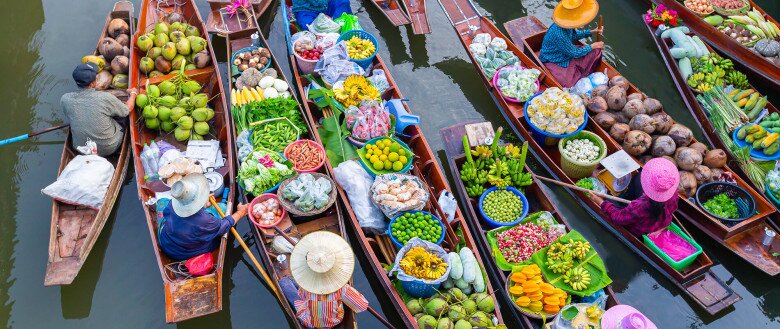
One of the most distinctive items on offer is the Nam Dok Mai mango, renowned for its luscious sweetness and thick, fiber-free flesh, often served with traditional coconut sticky rice. The Monthong durian, with its rich, creamy flavor, is harvested from ancient groves around the canal, offering a culinary experience like no other for first-time tasters.
The Queen pineapple, a small variety with a delicate sweet taste, thrives in the sandy loam soil of the surrounding area. This fruit is not only consumed locally but also exported to various countries in the region.
Showcase of Traditional Crafts
Beyond fresh produce, the Damnoen Saduak Floating Market also exhibits a range of handcrafted products that reflect the local artisanal heritage. Handmade Thai silk, woven from natural silk and dyed with colors extracted from trees, flowers, and plants, showcases exquisite craftsmanship in every thread.
Wooden artifacts inlaid with mother-of-pearl from workshops along the Ratchaburi canal merge Buddhist motifs with natural designs, resulting in unique artistic creations. Terracotta planters, made from the region’s characteristic red clay and adorned with wave patterns, hold cultural significance beyond their functional value.
Captivating Street Food Scene
The cuisine at the Damnoen Saduak Floating Market is a subtle blend of Western Thai flavors with Chinese culinary influences. Pla Pao, grilled freshwater fish marinated in salt and chili and wrapped in banana leaves, is typically served with the tangy nam jim sauce, leaving a lasting impression on the palate.
Khao Lam, a delicacy of sticky rice cooked in bamboo tubes with black beans and coconut milk, is not only delicious but also showcases traditional cooking ingenuity. Boat Noodles, featuring small rice noodles in a robust pork bone broth, accompanied by meatballs and herbs, have become a signature dish of the floating market.
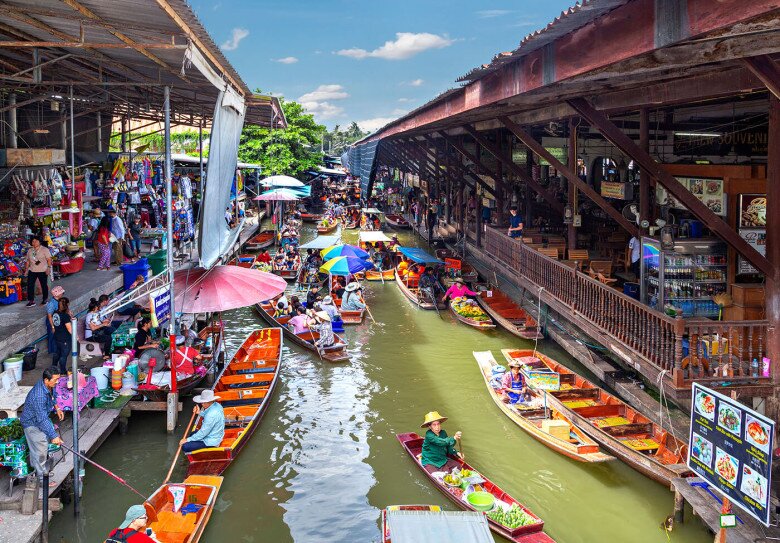
Beverages and desserts such as chilled Siamese coconut water, Khanom Bueang (crispy pancakes filled with coconut cream and salted egg yolk), and natural coconut ice cream topped with peanuts and grass jelly offer a diverse and indulgent culinary experience.
Navigating the Challenges of Mass Tourism
According to statistics from the Tourism Authority of Thailand, Damnoen Saduak currently attracts approximately 2,000–5,000 visitors daily, with a surge in numbers during the dry season from November to April. Of these visitors, 70% are international tourists, predominantly from China, South Korea, and European countries.
While the influx of tourists has brought significant economic benefits to the region, it has also presented challenges in preserving traditional culture. The proliferation of industrial souvenir shops threatens to overshadow the authentic floating market experience.
Recognizing this issue, local authorities have implemented a boat registration system to manage traffic on the canal and designated specific areas for large tour groups. Non-governmental organizations like the Heritage Conservation Association of Thailand have proposed re-planning the selling areas to prioritize local vendors and limit imported goods.
In 2023, the “Damnoen Saduak Authentic” project was launched to train local youth in sustainable tourism management and revive traditional crafts. This project aims not only to conserve the cultural heritage but also to provide stable employment opportunities for the local community.
The “Local Vendor” program, initiated by the Damnoen Saduak district administration, encourages tourists to purchase directly from certified boat vendors. Every transaction contributes to a fund for canal maintenance and local education development, embodying a model of socially responsible tourism.

For first-time visitors to Thailand, Damnoen Saduak is a must-see destination. Every bend in the canal unveils a story of a resilient water-based culture, where the past and present converge in the rhythmic paddle strokes, the lively calls of vendors, and the warm smiles of the local people.
The Damnoen Saduak Floating Market is not just a tourist attraction; it stands as a testament to a community’s ability to adapt and thrive amidst changing times. It offers a valuable lesson in sustainable development, one that each visitor can take away from this captivating land of aquatic charm.
The Heart of Hue: A Country Market with a Twist.
Nestled amidst the white sandy beaches of Thua Thien Hue, Vinh Thanh Market buzzes with vibrant energy amidst the tranquil countryside. Beyond being a mere trading hub for locals, this unique market convenes thrice daily, vividly portraying the distinct cultural practices of a region nestled between the sea and the lagoon.
Discover Thailand with Asia Legend Travel – An Unforgettable Journey in the Golden Temple Country
Uncover Thailand – the golden land of fascinating culture, delectable cuisine, and breathtaking beaches with Asia Legend Travel. This article will guide you through the remarkable destinations, must-try dishes, the perfect time to visit, and why Asia Legend Travel should be your choice for an unforgettable journey. If you seek a comprehensive Thailand travel guide, look no further!
“A Thai Treat: Cinnamon Spiced Bulot Snails Stir-fried to Perfection”
If you’re looking for a unique and delicious way to cook bulot snails, look no further! This mouth-watering Thai-style dish with a twist will tantalize your taste buds. With a perfect blend of spicy, sour, and aromatic flavors, this bulot snail stir-fry with cinnamon leaves is a true culinary delight.

























